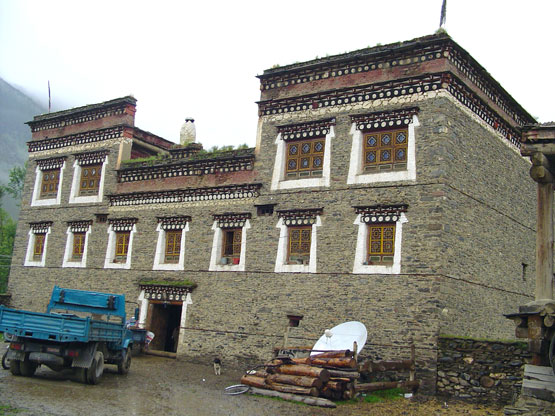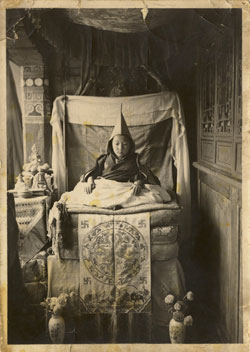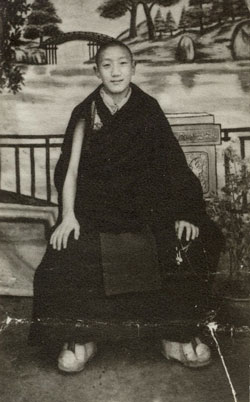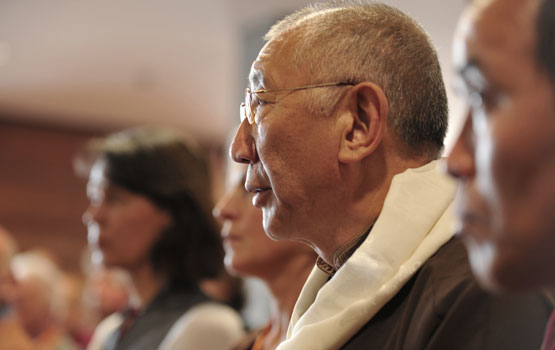
His Eminence Loden Sherab Rinpoche’s previous incarnation was the great translator Loden Sherab (1059–1109). The translator Loden Sherab was one of the renowned masters who went through much hardship to bring the Dharma texts from India to Tibet. Loden Sherab travelled to India and translated Dharma texts at Bodhgaya Monastery, and it was from here that he brought the infallible dharma protector Dharmapala Setrab to Tibet.

Five hundred years later, it was Dharmapala Setrab who rescued Dorje Shugden from being burnt during the fire pujas that were performed by Mindrolling Lama, one of the most skilled lamas in overcoming spirits. Mindrolling Lama had been tasked by the 5th Dalai Lama to exorcise Dorje Shugden but it was in vain as Dorje Shugden was not a spirit. Setrab has a very special relationship with Dorje Shugden, and Setrab is clearly depicted within Dorje Shugden’s mandala. The current Loden Sherab Rinpoche had the previous Kyabje Trijang Rinpoche as one of his main teachers.
The Lineage of the Dagyab Kyabgoens

The lineage of the Kyabgoens, “Lords of Protection”, of Dagyab goes back to Dragpa Gyatso (1572 – 1638). He was born in the region of Dagyab into a family who were followers of the Nyingma tradition of Tibetan Buddhism. Dragpa Gyatso went to study at Ganden Monastery near Lhasa in Central Tibet and became a well-known Gelugpa teacher and meditation master. After completion of his studies the 4th Dalai Lama, Yonten Gyatso (1589-1616), asked him to return to Dagyab to help people there in their spiritual pursuits. Back in Dagyab he gave many teachings and spent several years meditating in a cave that had a protruding rock outcrop. That is how he later became known by that name. His activities also took him to neighboring regions formerly called Chayuel, Kyongyuel, and Getshang. He accumulated a large following and his disciples became so devoted to him that, out of gratitude, they offered him all their land. Eventually, this led to the unification of these regions into one county which constitutes present day Dagyab County. He spent the rest of his life in Dagyab and because his vast activities brought much benefit and happiness to the area, he was later known as the Kyabgoen of Dagyab, the Protector Lord of Dagyab.
Since the 4th Kyabgoen of Dagyab, all following reincarnations have additionally held the title Hothogthu Nomonhan (Eng. Noble; Tib. ‘phags-pa, Skr. Arya). Hothogthus are among a small group of the highest ranking reincarnated lamas who were often reincarnations of Regents of Tibet. The present 9th Dagyab Kyabgon is the only Hothogthu living in the west.
In a prayer dedicated to the lineage of the Dagyab Kyabgoens, several Indian and Tibetan masters are mentioned as previous reincarnations of the Dagyab Kyabgoens. The most well known among them is the great translator Loden Sherab (1059-1109) from Central Tibet. Therefore, the Dagyab Kyabgoens were also known as Lama Loden Sherab. This name remains until the present. Thus the current 9th Kyabgoen of Dagyab holds the name H.E. Loden Sherab Dagyab Kyabgoen Rinpoche.
Finding the Reincarnation
In 1942/43, a delegation came from Dagyab to Menya in search of the reincarnation of the previous Kyabgoen of Dagyab. The delegates wanted to particularly examine one candidate, the then 2-year-old boy, Tsering Wangden of the Sampa-khapa family. The report of their findings was sent to the Central Tibetan government and His Holiness the Dalai Lama for a final decision.
At that time, the young boy had already been recognized as the reincarnation of the head lama of Giwakha Monastery in Menya. In 1944, the Dagyab delegation returned to Menya with the official recognition by the Dalai Lama of the four-year-old boy as the reincarnation of the late Dagyab Kyabgoen. Subsequently, this caused a conflict between the Giwakha and Dagyab monasteries. Until the dispute was settled Rinpoche had to stay in the monastery of Ngamchoe Goenpa in Dartsedo (Chinese “Khangdiang”), which is a border town and served as a neutral place. He stayed there for one year and nine months. During that time the people of Dagyab were not allowed to see him. It was then decided to perform seven days of prayers to Setrab, a protector deity. The ceremonies were to conclude in a divination that would decide on the issue. There were three choices: he was either the head of the Giwakha or the Dagyab monastery, or of both monasteries together. The divination fell in favor of Dagyab. As compensation,, the Dagyab delegation had to give the Giwakha monastery many material goods. Dagyab Rinpoche’s cousin, Choekyi Gyaltsen, was later recognized as the head lama of Giwakha monastery.
When Rinpoche was five years old, he moved from Dartsedo to Dagyab county. As soon as he reached the border the traditional first hair cutting ceremony was performed by Tsangsar Rinpoche, a highly respected Sakya lama in Dagyab. Tsangsar Rinpoche became Dagyab Rinpoche’s main teacher who taught and guided him in his Buddhist studies and practice for many years.
Rinpoche’s enthronement and early years of education

On the 3rd day of the 1st month of the Tibetan lunar calendar Rinpoche arrived at his principal monastery, Tashi Yangkyil which was also known as Magoen, in Yendum , the capital of Dagyab. On the very day of his arrival Rinpoche was formally enthroned as the 9th Kyabgoen of Dagyab. Representatives of the Central Tibetan government and of surrounding counties came to participate in the ceremony. A representative of His Holiness the Dalai Lama presented him with a yellow brocade. Written on it in cinnabar red pigment was his new name given by the Dalai Lama himself “Lobsang Tenzin Choekyi Gyaltshen”.
After three days of elaborate ceremonies and celebrations, Rinpoche took residence in the Royal Houses, the so-called “Gyalkhang”. He stayed in its main building, the Red Palace “Phodrang Marpo”, until the age of fourteen.
Rinpoche’s parents came to see him often as they had moved with him from Menya. His father slept next to him until his death at the age of forty-nine. The Master of Robes “Zimpoen” was one of Rinpoche’s personal attendants who also slept there dutifully. One of his two bodyguards, “Zimgag”, alternately slept in the anteroom. His parents and a few relatives had been offered by the Dagyab Labrang to stay in the summer residence of the Kyabgoens, which was situated at the foot of the hill close to his own residence. Nowadays, the local government uses this residence. Rinpoche’s father, Lobsang Dorje, was given the title of “Denchang” , “key-holder”, which represented a promotion to a higher rank. From then on he worked in the main administrative office called “Yigtsang”.
From the age of seven, Rinpoche was taught to read Tibetan scripts by his private senior tutor Tsonsang Tulku. He had to memorize many Buddhist texts, learn chanting and how to play religious musical instruments for use in ceremonies. His junior tutor, Geshe Kalsang Phuntsog, was responsible for teaching Rinpoche these skills. Both tutors were very strict but his junior tutor, in particular, was also very kind and skillful.
Even though at that time there were no clocks, Rinpoche’s daily routine looked roughly like this:
4:00AM – 6:30AM learning by rote by the light of butter lamps
7:00AM – 12:00PM reading practice
2:00PM – 4:00PM writing practice, rituals, and the use of religious musical instruments
4:00PM – 6:00PM reading practice
7:30PM – 10:00PM reciting the text that he had to memorize
Rest on Sundays was unknown in Tibet. During the year there were a few holidays according to the Tibetan Lunar Calendar, such as during the Tibetan New Year. There were summer picnics in Changrag, the Willow Tree Park. Children’s toys were also virtually unknown. Young Rinpoche was permitted to play with lumps of dough to form figures and he was happy when he could play in the park by a small stream. He was always surrounded by adults and did not know any children of his own age. A small dog named Manga was his regular playmate. Rarely did he leave the Red Palace, except when attending ceremonies outside the monastery or when going on summer picnics. Every year on the 15th day of the fourth month of the Tibetan calendar celebrating Saga Dawa, Rinpoche circumambulated the entire monastery on a so-called korwa. Saga Dawa commemorates three auspicious events, Buddha Shakyamuni’s birthday, the day he attained enlightenment and the day he went into paranirvana, and therefore marks one of the most important days of celebration in Buddhism.
Rinpoche was also taught meditation practices by his tutors under whose guidance he undertook several retreats.
Rinpoche’s higher studies and the arrival of the Chinese People’s Liberation Army
 In 1950 the Chinese People’s Liberation Army entered Chamdo and establised the “Chamdo People’s Liberation Committee”. Even though Rinpoche was only nine years old at the time, the Chinese authorities urged him to participate in their first conference in Chamdo and to join a group of only eight of the highest-ranking dignitaries “Zhuren”, a position which he was obliged to accept.
In 1950 the Chinese People’s Liberation Army entered Chamdo and establised the “Chamdo People’s Liberation Committee”. Even though Rinpoche was only nine years old at the time, the Chinese authorities urged him to participate in their first conference in Chamdo and to join a group of only eight of the highest-ranking dignitaries “Zhuren”, a position which he was obliged to accept.
It was customary for the Kyabgoen of Dagyab to travel to the outlying regions of Dagyab. This journey was meant for the benefit of the elderly and those unable to travel long distances to come and see Rinpoche at his monastery. On this six-month journey, he visited many farming and nomad areas, as well as monasteries and nunneries.
In 1954, at the age of fourteen, Rinpoche continued his studies at Drepung Loseling Monastery outside the capital of Lhasa in Central Tibet. At that time Drepung had about 9000 monks. He concentrated on the five main Buddhist philosophical subjects: Prajnaparamita, the perfection of wisdom; Madhyamika, the philosophy of the Middle Way; Vinaya, the canon of monastic discipline; Abidharma, metaphysics; and Pramana, logic and epistemology.

His Holiness the Dalai Lama appointed according to tradition the abbot of Drepung Loseling College, Ven. Geshe Pema Gyaltsen, as Rinpoche’s official tutor. Ven. Geshe Nyima Gyaltsen, Abbot of Shagkor Dratshang, also became his teacher in philosophy. Both were outstanding teachers of the time. The Dalai Lama himself received teachings from the latter. Rinpoche received most of the Vinaya and Abhidharmakosha teachings from Kyabje Ling Rinpoche, senior tutor to His Holiness the Dalai Lama later in the Indian Exile. Rinpoche received many Buddhist Sutra and Tantra teachings from 28 Masters. His main teachers are Kyabje Ling Rinpoche and Kyabje Trijang Rinpoche, who were the senior and junior tutors to His Holiness the Dalai Lama and His Holiness the Sakya Trizin.
In 1956, the Chinese Government set up the “Preparatory Committee for the Autonomous Region of Tibet” in Lhasa where Rinpoche had to attend weekly meetings on Fridays and Saturdays. Due to his high rank, he was given several titles by the Chinese government such as Wu Yuan of Standing Committee which he was obliged to accept even though, given his young age, he didn’t have much knowledge about administration.
Indian Exile and living in the West
In 1959, after the suppression of the Tibetan National Uprising in Lhasa by Chinese troops, Rinpoche escaped, according to his administrators’ plan, by leaving Drepung monastery for Sangphu in Southern Tibet. From there he left for the Tibetan-Indian border where he met with His Holiness the 14th Dalai Lama. His Holiness asked him to join him in exile in India.
Rinpoche finished his Buddhist studies in Dharamsala in Northern India. He received the Geshe degree, a doctorate in Buddhist Psycho-ethical Philosophy, which is equivalent to a PhD in Buddhist Philosophy in the West. From 1964 until 1966, he lived in New Delhi where he directed the Tibet House, an internationally recognized institute for the promotion and preservation of Tibetan and Buddhist culture. It was then that he was invited by the University of Bonn, Germany to work as a researcher at its Institute for Central Asian Studies, which he accepted.

His main area of interest included Tibetan Buddhist symbols, iconography and Tibetan religious art. He taught courses, as well as supported students and colleagues in their academic research work. He worked there until his retirement in 2004 and published several books connected to his research. A list of publications of his body of work, including academic papers about Tibetan Buddhist art, iconography and symbolism, translations of Buddhist texts from Tibetan into German, as well as various explanations for Western Buddhists, in both German and English can be downloaded. Among the Tibetan Tulkus in exile, Rinpoche is considered the one who holds the most lineages in the Gelug tradition.

As soon as Rinpoche left for Germany, he gave back his monk´s vows. This was not an easy decision to make. However, he envisioned it to be rather difficult to live as a monk in the Western world without the monastic environment. Naturally, there were big changes in his new way of life. He became a regular employee and led a “liberated” life, learning all kinds of chores in day-to-day life that were unfamiliar to him as a former monk in a monastery. He learned to take care of a household with tasks such as shopping, cooking, cleaning, emptying garbage, driving a car, etc., and took a special interest in sewing and carpentry. In 1969, Rinpoche married Norden Pemba with whom he has two grown-up children. His wife says about him “If someone needs him as a teacher, he will teach. If you want him to give a hand as a cook or driver, he is willing.”

In the 1980s, due to the explicit request of people interested in Buddhism he began to be active as a spiritual teacher for Europeans. Since 1984 Rinpoche has been teaching the Dharma, mainly in his own center in Frankfurt, the Choedzong Buddhist Society. He is also the Spiritual Director of Tibet House in Germany, which he co-founded with the Buddhist community Choedzong e.V.
Sources:
- http://www.dagyab-rinpoche.com/biography/the-lineage-of-the-dagyab-kyabgoens/
- http://www.dagyab-rinpoche.com/biography/finding-the-reincarnation/
- http://www.dagyab-rinpoche.com/biography/rinpoches-inthronisierung-und-die-fruehen-jahre-der-ausbildung-en-US/
- http://www.dagyab-rinpoche.com/biography/rinpoche-s-higher-studies-and-the-arrival-of-the-chinese-people-s-liberation-army/
- http://www.dagyab-rinpoche.com/biography/indian-exile-and-living-in-the-west/







































 English
English Indonesia
Indonesia Tibetan
Tibetan